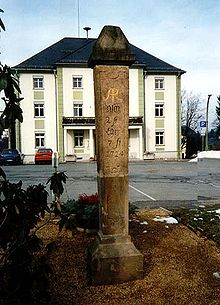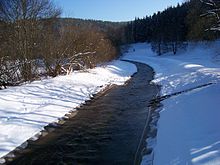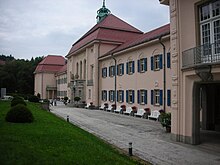Bad Elster
| coat of arms | Germany map | |
|---|---|---|

|
Coordinates: 50 ° 17 ' N , 12 ° 14' E |
|
| Basic data | ||
| State : | Saxony | |
| County : | Vogtland district | |
| Height : | 546 m above sea level NHN | |
| Area : | 19.77 km 2 | |
| Residents: | 3675 (Dec. 31, 2019) | |
| Population density : | 186 inhabitants per km 2 | |
| Postal code : | 08645 | |
| Area code : | 037437 | |
| License plate : | V, AE, OVL, PL, RC | |
| Community key : | 14 5 23 040 | |
| LOCODE : | DE BDE | |
| City structure: | 6 districts | |
City administration address : |
Kirchplatz 1 08645 Bad Elster |
|
| Website : | ||
| Mayor : | Olaf Schlott ( Independent Citizenship eV UB ) | |
| Location of the city of Bad Elster in the Vogtland district | ||

Bad Elster (until 1875: Elster ) is a health resort in the Saxon Vogtland district . The city is one of the oldest mineral and mud spas in Germany and belongs to the cross-border microregion Friends in the heart of Europe .
Geographical location
Bad Elster is located in the upper valley of the White Elster directly on the border with the Czech Republic in the triangle between Bohemia , Bavaria and Saxony near Plauen and Hof . The place is surrounded by higher wooded mountains that protect against extreme temperature fluctuations.
Districts
Bärenloh , Christiansreuth , Heißenstein , Kessel , Mühlhausen , Reuth and Sohl with Schwarzenbrunn.
history
The origin of the name is seen in the Germanic word Alistra , which has the old European root el- / ol- for to flow . The bird magpie in the city coat of arms can only be explained by the consonance of names.
Magpie until the end of the 18th century
The remains of a ring wall system (the so-called Old Castle ) located about two kilometers northwest of the town of Elster , which probably dates from around 1100, show that people settled there long before the town was first mentioned in a document in 1324.
In 1412 a manor was mentioned that was bought by the von Zedtwitz family and later belonged to the Franconian knight circle . It remained in the possession of this noble family until 1800. The place and its current districts belonged to the Voigtsberg office until the 19th century .
In 1533 the Reformation was introduced in Adorf and in the Elster branch church and in 1540 the first Protestant pastor was ordained in Elster.
The healing effect of the spring in the Elster valley (then known as Säuerling , today's Moritz spring ) was recognized early on. Georg Leisner, then Plauen city physicist and personal physician to the sovereign Duke Moritz von Sachsen-Zeitz , wrote in 1669 that "since time immemorial" not only the residents of Elster have used this water, but that people even came from Adorf and carried it home. It was also used by him "with many different patients with benefits ...".
The most famous guest of the place was Johann Wolfgang von Goethe , who came to Elster in 1795 and mentioned the Elsteraner spring in his work Hermann and Dorothea .
(Bad) Elster in the 19th and 20th centuries
It was not until 1851 that Elster became an independent parish, and in 1892 the neo-Gothic St. Trinity Church was consecrated. The old St. Peter and Paul Church was demolished.
Elster was elevated to the status of the Royal Saxon State Bath in 1848 , with which the number of bathers rose rapidly (1848: 129; 1850: 378; 1860: 1750; 1870: 2450; 1890: 5870; 1900: 8900; 1990: 15,600).
The place has been called Bad Elster since 1875 and has had city rights since 1935 . In 1880 the Bad Elster Bathing Museum was opened as the first museum in the city and the Vogtland . In 1898 the Bad Elster district heating plant went into operation. It was the first of its kind in Saxony and the second in the Empire.
On April 4, 1945, Reinhard Gehlen , later first President of the Federal Intelligence Service (BND), Gerhard Wessel , later second BND President, Hermann Baun , head of espionage against the Soviet Union in the Abwehr , and his adjutant Graber met in Baun's quarters Spa hotel. In the so-called "Pact of Bad Elster" they agreed to offer their knowledge of the Soviet Union to the United States after the Second World War . In May, the city was occupied by US Army soldiers who handed Bad Elster over to the Red Army in July . As the southernmost city in Saxony, Bad Elster then belonged to the SBZ and until 1990 to the GDR .
The title "Mineral and Moorheilbad" was awarded to Bad Elster in 2005 by the state of Saxony. The tour-wise inspection resulted in confirmation in November 2017.
Incorporations
| Former parish | date |
|---|---|
| Bärenloh | before 1880 |
| Christiansreuth | before 1880 |
| Heißenstein | before 1880 |
| Mulhouse | January 1, 1994 |
| Sohl (with Schwarzenbrunn) | January 1, 1994 |
| Reuth | before 1880 |
memorial
- Burial in the local cemetery for four name unknown prisoners of war who, during the Second World War, victims of forced labor were
Population development
Development of the population (from 1964 December 31st) :
|
|
|
|
politics


City council
Since the city council election on May 26, 2019 , the 14 seats of the city council have been distributed among the individual groups as follows:
| Party / list | Seats | + / - |
| Independent Citizenship (UB) | 7th | + 3 |
| Free voters Bad Elster e. V. (FW) | 2 | - 1 |
| CDU | 3 | ± 0 |
| SPD | 1 | - 1 |
| The left | 1 | - 1 |
mayor
In June 2015 Olaf Schlott was elected mayor.
coat of arms
“In gold, a natural magpie on three green hills; A silver spring breaks out of the middle, the water of which gathers in the shield river. "
Town twinning
The spa town of Bad Waldsee in Baden-Württemberg has been a twin town of Bad Elster since 1990.
Attractions
The most important buildings in Bad Elster were built in the late 19th and early 20th centuries.
- The Royal Kurhaus was built from 1888 to 1890 based on a design by the master builder Karl Otto Trobsch . The building is an architectural example of the neo-renaissance and an impressive testimony to the value of the state pool, its international importance and its acceptance by bathers at the end of the 19th century. The bathing museum (also called the Saxon bathing museum) represents these epochs.
- The Albert Bath was built around 1908 based on a design by the Dresden architects Rudolf Schilling and Julius Graebner ( Schilling & Graebner office ). In the GDR, the name Albertbad was no longer officially used after 1952, but the name Neues Badehaus was used.
- The König Albert Theater was built in 1913/1914 based on a design by the Chemnitz architects Alfred Zapp and Erich Basarke under the name Kurhaus , which was discarded after 1990 . It replaced a previous building from 1888 and was extensively renovated after 1989. The theater is under the patronage of Alexander Prince of Saxony. Due to the year-round schedule, the König Albert Theater has become the most important event location in the region, giving the cultural life of the Vogtland and the Euregio Egrensis decisive impulses.
- The NaturTheater, opened in 1911, is located in a wooded area and is considered the oldest open-air theater in Saxony. In 2007 it was adapted to open-air requirements and reopened with a festive celebration. Since then there has been a program of opera, operetta, drama, concerts, cinema and folklore every year from May to September.
- The Evangelical Lutheran St. Trinity Church in neo-Gothic style , consecrated in 1892, has some art objects from the previous church, such as B. two Gothic figures of the apostles Peter and Paul (approx. 1490).
- The former palace hotel Wettiner Hof was built in 1908 by the architects Zapp and Basarke, after 1945 it was used as the Karl-Marx-Hof sanatorium . The building was a listed building and had been waiting for an urgently needed renovation since the fall of the Wall. The last badly dilapidated building was demolished in early summer 2011 as no investor could be found for the renovation.
- The combined heat and power plant, built in 1898, is the oldest district heating plant in Saxony.
- There are also a number of small monuments, such as B. the Saxon half-mile column from 1724 and the Schiller monument.
Economy and Transport
The main line of business is tourism and rehabilitation cures in seven clinics. In 2005 there were 35 accommodation facilities in the village, which offered a total of 2,400 beds. With almost 40,000 overnight guests, around 540,000 overnight stays were counted in the course of this year.
The place is close to the federal highway 92 , but without being exposed to through traffic.
There are two border crossings to the Czech Republic. On June 30, 2008, the expanded pedestrian crossing to Rossbach-Pfannenstiel ( Hranice -Krásnany) was upgraded to a crossing for vehicles up to 3.5 tons. On September 1, 2008, after the roadway had been renovated, the crossing to Aš - Doubrava (ash green) was opened for cars.
Bad Elster train station on the Plauen – Eger railway line is about 2.5 kilometers from the main town on the outskirts of the Mühlhausen district and is served by Vogtlandbahn trains every two hours . Furthermore, Bad Elster is the starting point for regularly operated bus connections, e.g. B. to Plauen or Klingenthal .
A citizens' bus with volunteer drivers has been running within Bad Elster since March 2017 . For the time being, it runs every Tuesday and Thursday and connects the town with the train station.
The health resort is on the Elster cycle path .
Education and Research
Bad Elster has a primary school and a kindergarten. The Medfachschule Bad Elster, a private medical vocational school for health professions, trains young people to become masseurs and medical pool attendants , occupational therapists and physiotherapists .
A department of the Federal Environment Agency based in Bad Elster deals with the areas of drinking and bathing pool water hygiene, water treatment and the toxicology of drinking and bathing pool water. The institute emerged from the drinking water research area of the former research institute for hygiene and microbiology in the GDR. It is run by the World Health Organization as the WHO Collaboration Center for Research on Drinking Water Hygiene .
The Institute for Balneology and Spa Studies run by the Free State of Saxony was privatized by the Free State of Saxony at the end of 2006 and has since been operated as a private institute by the long-time director Ludwig Resch. Until then, it was the only state research facility of its kind in Germany.
Personalities
literature
- Bad Elster near Adorf in the Saxon Voigtlande. According to official sources topographically, geognostically, chemically, medically and historically described at the instigation of the royal. Ministry of the Interior . Publisher by Leopold Voss, Leipzig 1853 digitized
- Robert Flechsig: Bad Elster . Weber, Leipzig 1884 ( digitized version )
- Moritz Heger: Elster in Voigtlande and its healing springs . Naumann, Dresden 1850 ( digitized version )
- Herrmann Helmkampf: Bad Elster in Saxony. A presentation of everything worth knowing for spa guests and friends of the spa . Berlin 1883 ( digitized version )
- Herrmann Helmkampf: Guide through Bad Elster and the surrounding area . Leipzig 1894 ( digitized version )
- Johann Gottlieb Jahn : Bad Elster in Voigtlande, with special consideration of all mineral springs in the upper Voigtland . Oelsnitz 1856 ( digitized version )
- Paul Kohl: Bad Elster. His remedies and therapeutic successes . Leipzig 1859 ( digitized version )
- Otto Korn: Bad Elster and its surroundings. A guide for spa guests and tourists , Kafemann, Danzig 1873 ( digitized version )
- Hermann Peters: The sources and baths of Elster . Wigand, Leipzig 1875 ( digitized version )
- Richard Steche : Bad Elster. In: Descriptive representation of the older architectural and art monuments of the Kingdom of Saxony. 10th booklet: Oelsnitz official administration . CC Meinhold, Dresden 1888, p. 7.
- Gotthilf Wilhelm Schwartze: Elster health resort in the Saxon Voigtlande, its properties and healing powers . Leopold Voss, Leipzig 1854 ( digitized version )
- Christoph Flämig u. a .: Bad Elster. Landscape and history. , Verlag Sachsenbuch, Leipzig 1992, ISBN 3-910148-44-1
Web links
- Homepage of the city of Bad Elster
- Information about Bad Elster
- Saxon State Baths Bad Elster Bad Brambach
- GenWiki article on Bad Elster
Individual evidence
- ↑ Population of the Free State of Saxony by municipalities on December 31, 2019 ( help on this ).
- ^ Ernst Eichler and Hans Walther : Saxony. All city names and their history , Faber and Faber Verlag, Leipzig 2007, ISBN 978-3-86730-038-4 , p. 57f.
- ^ Bad Elster in the Digital Historical Directory of Saxony
- ↑ Digitized version of the book Acidularum Elistranarum lympha: Das ist, Kurtzer report des Elster-Sauerlings ... , 1669
- ↑ Article on the Bad Elster district heating plant
- ↑ Magnus Pahl : Hermann Baun (1897–1951) - Failed chief of espionage . In: Helmut Müller-Enbergs , Armin Wagner (ed.): Spies and news dealers - secret service careers in Germany 1939–1989 . 1st edition. Ch. Links Verlag , Berlin 2016, ISBN 978-3-86153-872-1 , p. 52 .
- ^ Ortschronik Bad Elster
- ↑ Freie Presse, November 4, 2017, p. 2
- ↑ a b c d The Saxony Book, Kommunal-Verlag Sachsen KG, Dresden, 1943
- ↑ a b State Statistical Office of the Free State of Saxony: Area changes
- ↑ www.wahlen.sachsen.de: Results of the municipal council election 2019 - Bad Elster
- ^ Result at Sachsen.de , accessed on July 3, 2018
- ↑ Eckart Roloff and Karin Henke-Wendt: First a personal physician, then Goethe and five pioneers. In: Visit your doctor or pharmacist. A tour through Germany's museums for medicine and pharmacy. Volume 1, Northern Germany. Verlag S. Hirzel, Stuttgart 2015, pp. 171-173, ISBN 978-3-7776-2510-2
- ↑ Eckhard Sommer: Exciting insight into the oldest district heating plant in Saxony . In: Free Press . July 24, 2018.
- ↑ The curious explore another way in the spa. ( Memento from September 5, 2008 in the web archive archive.today ) In: Freie Presse , September 2, 2008.
- ↑ Vogtlandauskunft - Lines & Networks - Transport and Lines - Citizen Bus. (No longer available online.) Formerly in the original ; accessed on June 16, 2017 . ( Page no longer available , search in web archives ) Info: The link was automatically marked as defective. Please check the link according to the instructions and then remove this notice.
- ↑ Plauen online magazine: Vogtland citizens' bus association receives three minibuses - www.spitzenstadt.de. Retrieved June 16, 2017 .

















